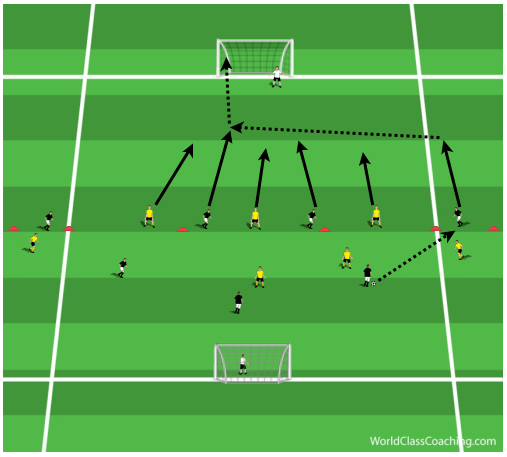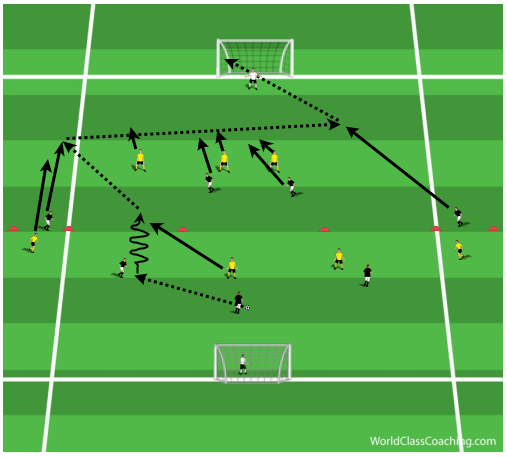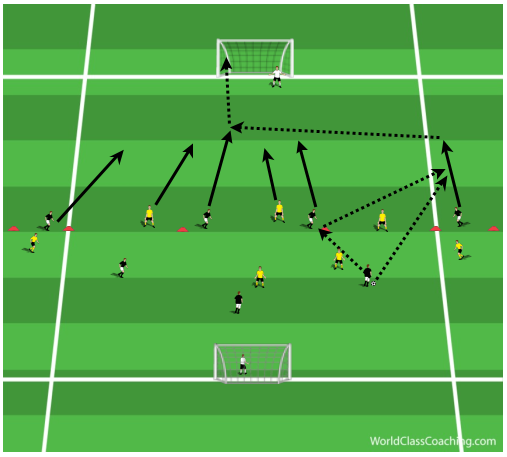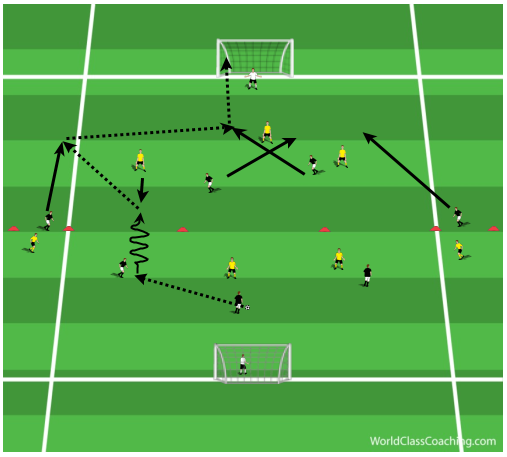Attacking Through the Wide Areas
By Sean Pearson
Small Sided Game: Attacking Through the Wide Areas
Area: 45x40yards
Players: 16
Teams: 2
Length: 20-25mins
This game has 3 areas. 2 wide areas (5x45) and a middle area (45x30). Each area is split into 2 halves. It is 3v2 in both middle sections and each wide area has a single unopposed player. When the ball is not in the player’s half of the field they must all come towards the middle of the field to simulate a ‘high line’. Make sure to inforce offside if a player is beyond the last defender when the ball is passed.
Objectives
- To get the ball to the wide players
- For the wide player to understand how, where and why to cross the ball
- Where and when to make a forward run

When the team with 3 players in the middle area has the ball they look to get the ball out to the wide player. The team’s first pass to the wide player’s feet. They then run with the ball down the line as quickly as they can. Because of the ‘high line’ we set, as the wide player looks up they should see space behind the defense. The cross is then played in front of one of the strikers on the ground. The reason it is on the ground is because 1) there is no one to get the ball over and 2) it is easier to control and finish. However imprecise passes will be cut out.
Progression 1
Players can now play a ball into space ahead of the wide player, for them to run on to. This can either be done directly from a player in the lower area or by a pass from the striker. The wide player can either play a one time cross or control the cross. The opposite wide player can also enter the middle area by coming in at the back post, but must return when possession is lost. Meantime during the attack the opposite area sets up for a high line again.
Progression 2
Now tell your defending side to sit deeper to deny space in behind. To combat this players can dribble the ball into the opposing half. Tell the player dribbling to commit a defender on one side of the field. Do this by dribbling at them not away from them. When they are close to the ball pass wide. This will now give space to cross the ball on the ground. Tell your two strikers or 9 & 10 to cross their runs to confuse the defender and still allow the opposite wide player to enter the middle area. Aim to cross the ball low to the front post as you should have a player running onto it to finish into the corner.

Progression 3
Have players dribble into the opposite area still, but players will naturally not commit now because they continually get beat. So they will start to drop. Pass to the space in front of the wide player but this time allow the opposing wide player on their side to apply pressure and chase them down (You can start off slow by saying they can’t tackle). Tell your two strikers (9 & 10) to run across the face of the defenders towards the ball. This will bring the defender across leaving more space at the back post. Have you opposite wide player come in off the line and the crosser should aim to get the ball high, over the heads of everyone else, to the back post. The striker’s movement creates the space for the opposite wide player.
It is important to relay to your wide players to look at the scenario before crossing. If players begin they realize the ball will always go to the back post it will decrease its effectiveness. So if players begin to back off expecting a high ball back post, this is the perfect time for a low front post cross.
Progression 4
Allow the players to make their own decisions completely depending on if the defense is high or deep, or call from the side ‘high’ or ‘deep’ and the attacking team must figure out how to attack through the wide areas.
By Sean Pearson. Sean is also the author Coaching Team Shape in the 3-3-1, Coaching Team Shape in the 4-2-3-1 and Coaching Team Shape in the 4-3-3




